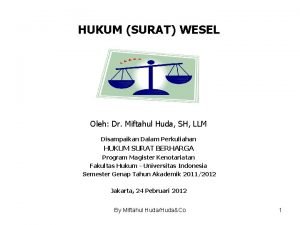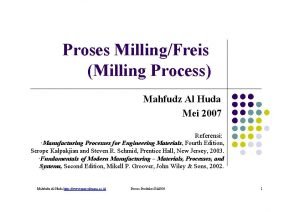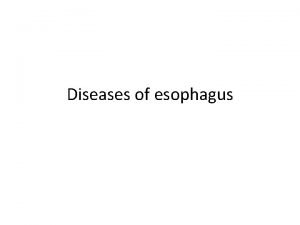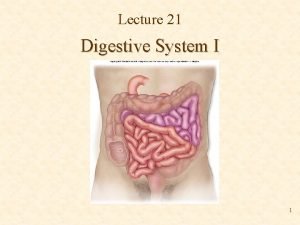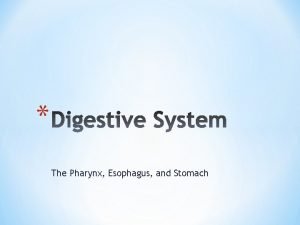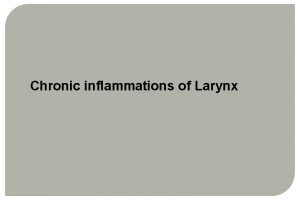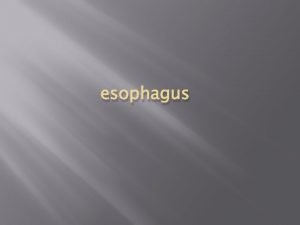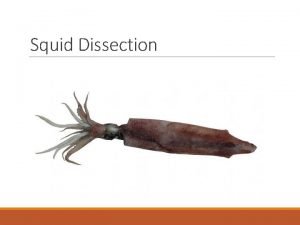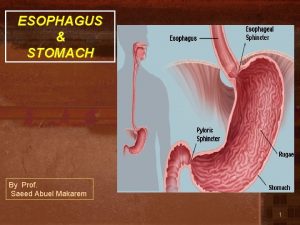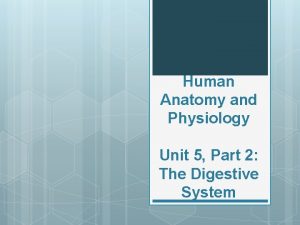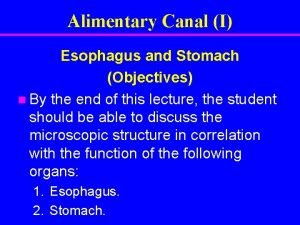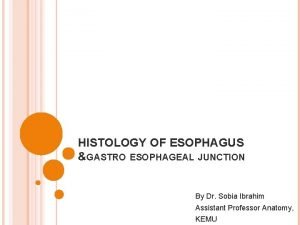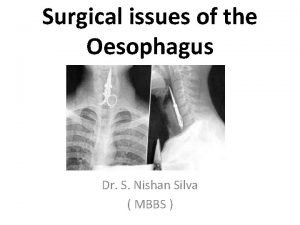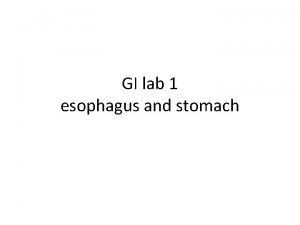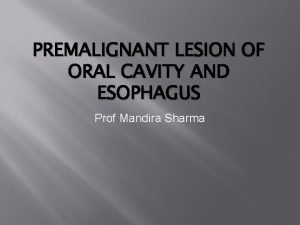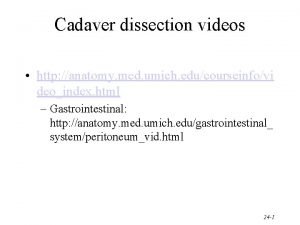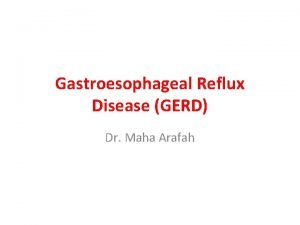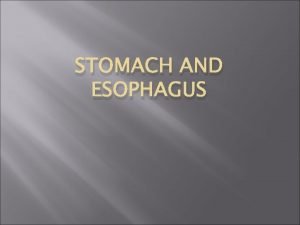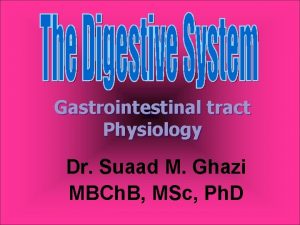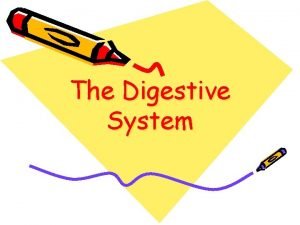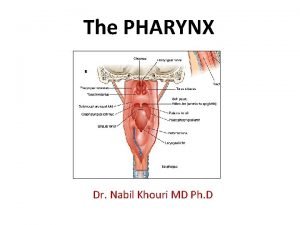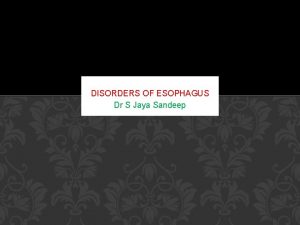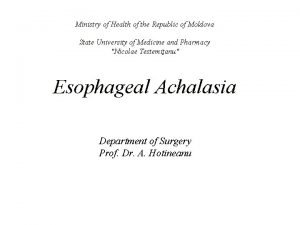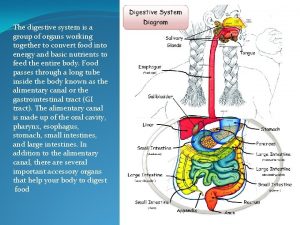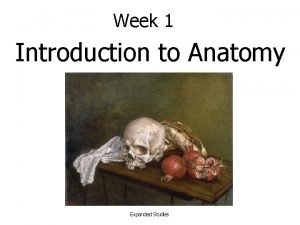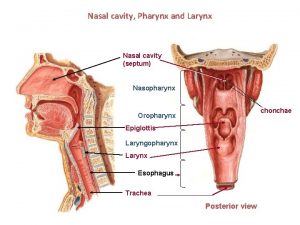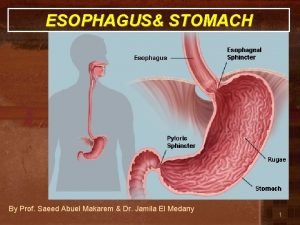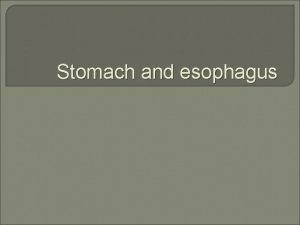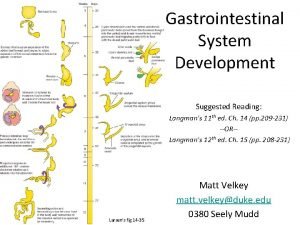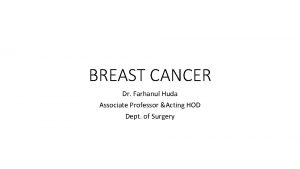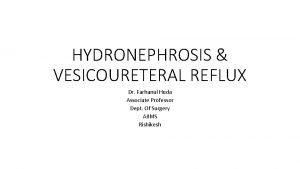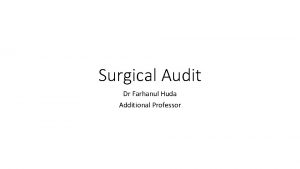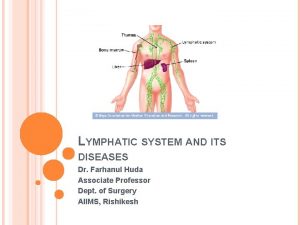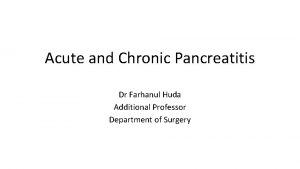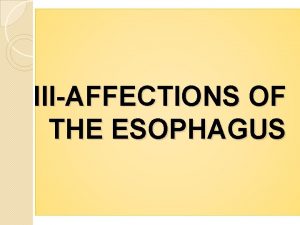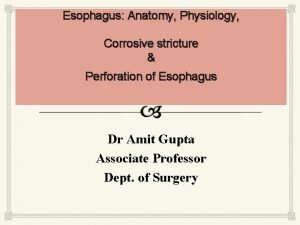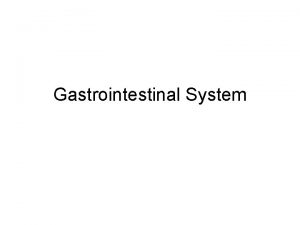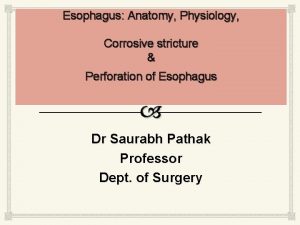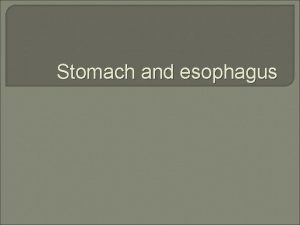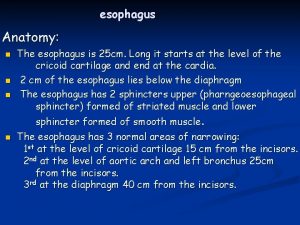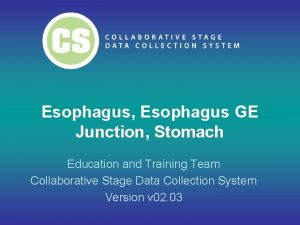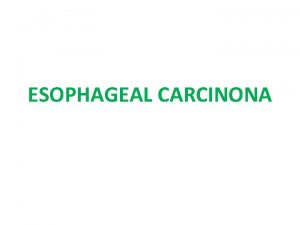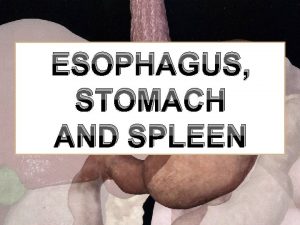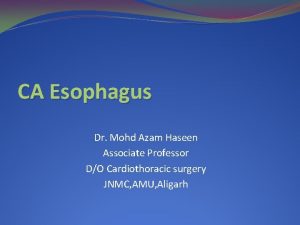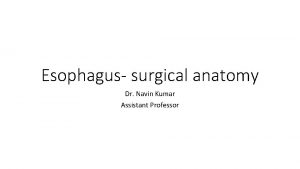ESOPHAGUS Dr Farhanul Huda Associate Professor Dept of






































- Slides: 38

ESOPHAGUS Dr. Farhanul Huda Associate Professor Dept. of Surgery 1

OBJECTIVES • By the end of this lecture the student should be able to • Describe the anatomy of the esophagus: extent, length, parts, strictures, relations, blood supply, innervation and lymphatics. 2

ESOPHAGUS Cervical • Tubular structure about 25 cm long. • Begins at the level of C 6. • Pierces the diaphragm at. T 10. • It is divided into 3 parts: • 1 - Cervical. • 2 - Thoracic. • 3 - Abdominal. • Proximal and distal- oncosurgery thoracic Abdominal 3

RELATIONS CERVICAL PART Posteriorly Post: Vertebral column. Laterally: Lat: Lobes of the thyroid gland. • Anteriorly: • Ant: Trachea and the recurrent laryngeal nerves. • • 4

THORACIC PART • In the thorax, it passes downward and to the left through superior then to posterior mediastinum • At the level of the sternal angle, the aortic arch pushes the esophagus again to the midline. 5

Thoracic part ANTERIOR RELATIONS • Trachea • Left recurrent laryngeal nerve • Left principal bronchus • Pericardium • Left atrium 6

POSTERIOR RELATIONS – Thoracic duct • • • Bodies of the thoracic vertebrae Thoracic duct Azygos vein Right posterior intercostal arteries Descending thoracic aorta (at the lower end) 7

LATERAL RELATION • On the Right side: • Right mediastinal pleura • Terminal part of the azygos vein. • On the Left side: • Left mediastinal pleura • Left subclavian artery • Aortic arch • Thoracic duct 8

ESOPHAGUS AND LEFT ATRIUM • close relationship • What is the clinical application? • A barium swallow will help the physician to assess the size of the left atrium (dilation).

RELATIONS IN THE ABDOMEN • In the Abdomen, the esophagus descends for 1. 3 cm and joins the stomach. • Anteriorly, left lobe of the liver. • Posteriorly, left crus of the diaphragm. • • Fibers from the right crus of the diaphragm form a sling around the esophagus. At the opening of the diaphragm, the esophagus is accompanied by: – The two vagi – Branches of the left gastric vessels – Lymphatic vessels. 10

ESOPHAGEAL CONSTRICTIONS • The esophagus has 3 anatomic constrictions. • The first is at the junction with the pharynx(pharyngeoesophageal junction). • The second is at the crossing with the aortic arch and the left main bronchus. • The third is at the junction with the stomach. • They have a considerable clinical importance. • Why?

1. They may cause difficulties in passing an endoscope. 2. In case of swallowing of caustic liquids (mostly in children), this is where the burning is the worst and strictures develop. 3. The esophageal strictures are a common sites of the development of esophageal carcinoma. 4. In this picture what is the importance of the scale?

ARTERIAL SUPPLY • Upper third by the inferior thyroid artery. • The middle third by the thoracic aorta. • The lower third by the left gastric artery. 13

VENOUS DRAINAGE • The upper third drains in into the inferior thyroid veins. • The middle third into the azygos veins. • The lower third into the left gastric vein, which is a tributary of the portal vein. • NB. Esophageal varices.

LYMPH DRAINAGE • The upper third is drained into the deep cervical nodes. • The middle third is drained into the superior and inferior mediastinal nodes. • The lower third is drained in the celiac lymph nodes in the abdomen. 15

NERVE SUPPLY • It is supplied by sympathetic fibers from the sympathetic trunks. • The parasympathetic supply comes form the vagus nerves. • Inferior to the roots of the lungs, the vagus nerves join the sympathetic nerves to form the esophageal plexus. • The left vagus lies anterior to the esophagus. • The right vagus lies posterior to it. 16

CARDIAC ORIFICE • It is the site of the gastroesophageal sphincter. • It is a physiological rather than an anatomical, sphincter. • Consists of a circular layer of smooth muscle (under vagal and hormonal control). • Function: • Prevents (GER) regurgitation (reflux) • NB. Notice the abrupt mucosal transition from esophagus to stomach (Z- line) 17

Microscopic anatomy • 2 layers of muscles- longitudinal and circular. • Lined by non keratinizing stratified squamous epithelium. • Squamocolumnar jn.

Recap • Length ? • Parts? • Arterial supply? • Venous drainage? • Constrictions ? • Relation with lt atrium? • Barett’s esophagus?

Stricture

• Causes can be grouped into: • Intrinsic – due to inflammation, fibrosis or neoplasia • Extrinsic – due to external compression • Disruption of peristalsis

Proximal and mid esophagus • • • Caustic ingestion (acid or alkali) Malignancy Radiation therapy Infectious esophagitis - Candida, herpes simplex virus (HSV), cytomegalovirus (CMV), human immunodeficiency virus (HIV) AIDS and immunosuppressed patients Diseases of the skin - Pemphigus vulgaris, benign mucous membrane (cicatricial) pemphigoid, epidermolysis bullosa dystrophica Idiopathic eosinophilic esophagitis Extrinsic compression Squamous cell carcinoma

Distal esophagus • Peptic stricture • Adenocarcinoma • Collagen vascular disease - Scleroderma, systemic lupus erythematosus (SLE), rheumatoid arthritis • Extrinsic compression • Alkaline reflux following gastric resection • Sclerotherapy and prolonged nasogastric intubation

• Heartburn • Dysphagia, odynophagia • Food impaction • Weight loss • Chest pain • Poor nutritional status • Patients with collagen vascular diseases -- joint abnormalities, calcinosis, telangiectasias, sclerodactyly, or rashes • Virchow node

Corrosive injury • Accidental or suicidal. • The type of agent, its concentration and the volume ingested determine the extent of damage. • Pathophysiology: • Alkalis cause liquefaction that leads to fibrous scarring. • Acids cause coagulative necrosis with eschar formation, and this coagulum limit penetration to deeper layers. • Acids cause more gastric damage because of intense pylorospasm with pooling in the antrum.

Treatment • Supportive • Feeding jejunostomy until patient starts swallowing saliva. • Repeated endoscopy and dilation. • Esophageal replacement for very long or multiple strictures. Why not resection?

Corrosive injury- Key points Skilled early endoscopy is mandatory

Esophageal perforation

• Usually iatrogenic or due to ‘barotrauma’. • Spontaneous perforation is a life-threatening condition. • Iatrogenic perforation can be managed conservatively. • Can be pathological • Due to penetrating injury or foreign body

Barotrauma (spontaneous perforation, Boerhaave syndrome) • occurs classically when a person vomits against a closed glottis. • The pressure in the oesophagus increases rapidly, and the • oesophagus bursts at its weakest point in the lower third, sending • a stream of material into the mediastinum and often the • pleural cavity as well. The condition was first reported by • Boerhaave, who reported the case of a grand admiral of the • Dutch fleet who was a glutton and practised autoemesis. • Boerhaave syndrome is the most serious type of perforation

Pathophysiology Vomitting against closed glottis Pressure in esophagus increases Perforates at its weakest point Mediastinitis

Clinical presentation • Severe pain in the chest or upper abdomen following a meal or a bout of drinking • SOB • Sometimes misdiagnosed as MI, perforated peptic ulcer or pancreatitis • Rigidity of the upper abdomen • Dec. breath sounds • Dullness on percussion, subcutaneous emphysema • In late cases sepsis is present

Investigations • CXR - air in the mediastinum, pleura or peritoneum. • Pleural effusion • A barium swallow • CECT

Iatrogenic injury • Most common cause of esophageal perforation. • Most common site is the cricopharyngeus. • Factors associated with increased risk are including large anterior cervical osteophytes, the presence of a pharyngeal pouch and mechanical causes of obstruction • It may follow biopsy • Patients undergoing therapeutic endoscopy have a 10 times greater perforation risk than those undergoing diagnostic endoscopy.

Treatment • Aim is to limit mediastinal contamination and infection • The decision between operative and non-operative management rests on four factors: 1 the site of the perforation (cervical vs. thoracoabdominal oesophagus) 2 the event causing the perforation (spontaneous vs. instrumental) 3 underlying pathology (benign or malignant) 4 the status of the oesophagus before the perforation (fasted and empty vs. obstructed with a stagnant residue).

• Indications for non-operative management include: • pain that is readily controlled with opiates; • absence of crepitus, diffuse mediastinal gas, hydropneumothorax or pneumoperitoneum; • no evidence of widespread extravasation of contrast material; • no evidence of on-going luminal obstruction or a retained foreign body. • patients who have remained clinically stable despite diagnostic delay. • The principles of non-operative management are hyperalimentation, nasogastric suction and broad-spectrum intravenous antibiotics.

• Surgical management is indicated when: • Patients are unstable with sepsis or shock • Have evidence of a heavily contaminated mediastinum, pleural space or peritoneum. • Surgery can be a primary repair, creation of an external fistula or resection.

Key points • Most perforations are iatrogenic. • Surgical emphysema is pathognomonic. • Complications are mediastinitis and sepsis. • Treatment is both conservative or surgical but requires specialised care.
 Promotion from associate professor to professor
Promotion from associate professor to professor Dr miftahul huda sh llm
Dr miftahul huda sh llm Huda khayrallah
Huda khayrallah Contoh anggaran tenaga kerja
Contoh anggaran tenaga kerja Swot analysis sephora
Swot analysis sephora Al huda artinya
Al huda artinya Mahfudz al huda
Mahfudz al huda Mechanical obstruction of esophagus
Mechanical obstruction of esophagus Pharynx and oral cavity
Pharynx and oral cavity Stomach labeled
Stomach labeled Mouse nibbled appearance of vocal cord is seen in
Mouse nibbled appearance of vocal cord is seen in Tubular esophagus
Tubular esophagus Mallory wiess tear
Mallory wiess tear Kingdom of squid
Kingdom of squid Esophagus
Esophagus Lamina propria
Lamina propria Serosa vs adventitia
Serosa vs adventitia Ge junction histology
Ge junction histology Slokdarm hernia
Slokdarm hernia Esophagus
Esophagus Peristaltic contraction
Peristaltic contraction Esophagus frog function
Esophagus frog function Premalignant lesions of esophagus
Premalignant lesions of esophagus Pancreas anatomy cadaver
Pancreas anatomy cadaver Barrett's esophagus
Barrett's esophagus Orifices of stomach
Orifices of stomach Gastric glands
Gastric glands Digestive system for labelling
Digestive system for labelling Parietal peritoneum
Parietal peritoneum Dr nabil khouri
Dr nabil khouri Varus esophagus
Varus esophagus Tortuous esophagus
Tortuous esophagus Esophagus stomach small intestine large intestine
Esophagus stomach small intestine large intestine Lung and esophagus
Lung and esophagus Pvt tim hall
Pvt tim hall Larynx
Larynx Medany el-makarem
Medany el-makarem What is cardiac orifice
What is cardiac orifice Septum transversum
Septum transversum

